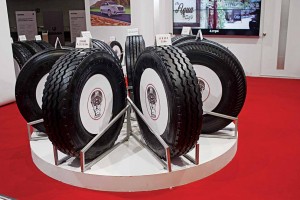MRF is developing new formulations to make tyres efficient, and to make production sustainable.
Story by: Bhargav TS
Announcing a 2.65 per cent rise in the total income at Rs.4,060.93 crore against a total income of Rs.3,955.93 crore last year, MRF Ltd. is working on new formulations with special properties. Claimed to command a 24 per cent market share of the Indian tyre market with 95 per cent of the revenues coming from two wheeler, passenger vehicle and commercial vehicle tyres, the company is evaluating new generation materials to produce efficient tyres. It is also looking at increasing the production sustainability of tyres. Confident of growth in-line with the good sales performance of CVs in the last quarter, the company is expecting radialisation in CVs to continue. In heavy-duty commercial vehicles in India, radialisation is 38 per cent. In light-duty commercial vehicles, it is 40 per cent. To help OEMs to meet emission and other challenges, MRF is working closely with its suppliers to tap the latest developments when it comes to raw materials. The company is also initiating design process of a tyre by recording customer inputs. Working on the development of tyres that will enhance fuel efficiency, a 300 strong R&D and product development division of MRF are claimed to be working closely to achieve this goal. They are presenting the company with the strength and the feasibility to produce tyres from nano materials. According to KM Mammen, Chairman and Managing Director, MRF Ltd., nano materials are currently used in certain areas. Price is proving to be a challenge.
New materials
Experimenting with the use of raw materials derived from environment friendly sources like biomass and waste materials to reduce the rolling resistance of tyres, MRF is claimed to look at sand. “We are doing a lot in terms of making fuel efficient tyres. Rolling resistance is important in the context of new emission standards,” said Mammen. He informed that the company is producing low resistance tyres for some segments. Said to be working on new projects that will result in tyres, which will enhance fuel efficiency, the focus, it is clear, is on new formulations. With price an important element, MRF is tapping into institutions and universities for knowledge. It is looking at new designs and patterns, and NVH and tyre simulations to reduce the rolling resistance and noise of tyres. Touching upon the development of fuel efficient tyres for passenger cars and trucks, Mammen averred, “The development of new designs, and the use of advanced materials is resulting in new products that will meet stringent customer requirements. To achieve higher accuracy, we have modernised our plant and machinery. We want to improve productivity and quality. We are therefore automating the manufacturing process to reduce manual intervention.”
Looking at indigenous materials that will help to retain margins by substituting the use of imported raw materials MRF is working to improve process efficiency, machine utilisation, and reduce power, fuel and material consumption. Paying close attention to the regualtory as well as market changes, which could have a significant effect on its operations, the company is building a complete range of automotive tyres, including TBRs, TBBs, PCRs and LTRs. Producing tyres for the Sukhoi 30 fighter jet of the Indian Air Force, MRF, to keep ahead of the competition in the two wheeler segment, launched Masseter range of tyres recently. These are engineered to perform and deliver supperior grip and control. For the CV tyre market, the company is closely following developments like GST, Motor Vehicles Act ammendment, and sales trends across categories. Informed Mammen, “M&HCV production numbers were stagnant last year but the last quarter saw a boost driven by the transition to BSIV. The proposed cap on the age of commercial vehicles will have a significant impact on the segment’s radialisation drive. The New Motor Vehicles Act is also expected to be passed, and if and when it is, it will have a significant impact on overloading. It will also have an impact on how vehicles are configured in the industry to meet geographical peculiarities of the logistics business.”
With the sale of new CVs likely to lack lustre in the first half of FY2017-18, the surge in tyre demand as operators decide to retain their existing fleet could provide MRF with a strong aftermarket stint. Setting up a facility at Bharuch, Gujarat, to support North and West India markets with an investment of Rs.4,500 crore, MRF has invested in e-commerce. While the Bharuch facility – one of the biggest among the eight plants the company has in India, is expected to go on stream in early 2018, the e-commerce initiative is finding takers in certain pockets like Pune. Averred Mammen, “The new factory will make all kinds of tyres and cater to the domestic and export markets. Work on e-commerce across the country is on too.” Confident of the e-commerce initiative to provide a new channel of growth, and will make it easier for the customer, Mammen concluded, “We are focusing on how to meet customer expectations and deliver what he needs.”





























